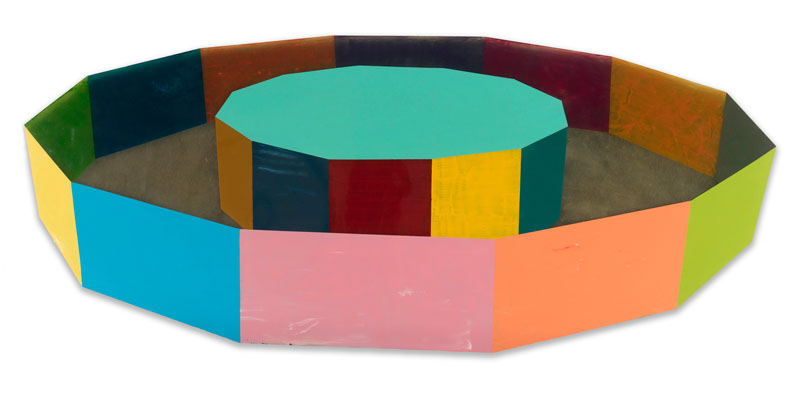Paintings By Ron Davis On Display This Week –
By MARY KING • 1972 •
Like love, the paintings of Ron Davis must be experienced to know what all the shouting’s about. There has been shouting, and from the look of his show, at the Helman Gallery through Friday, it is deserved.
In polyester resin and fiberglass polygons, a gently but calculatedly imprecise geometry describes and ultimately defies the third dimension of volume or depth.
Davis describes three-dimensional geometric “constructions” made of planes. He then tries to keep the surfaces flat by color and texture — a resolution of contradictions.
In “Plane Slab” of 1970, and the smaller “ELL” and “ELR,” the planes are translucent, the over-all shape or silhouette irregular, and the interior geometry or image abstract but clearly readable. It is abstract particularly in comparison with three paintings in the front room that date from 1968 and 1969.
 In these, “Whole,” “Paolo” and “Disc,” the geometric illusionism is reminiscent of familiar forms, thus giving an illustrative aspect.
In these, “Whole,” “Paolo” and “Disc,” the geometric illusionism is reminiscent of familiar forms, thus giving an illustrative aspect.
The form of “Disc” (1968) for example, is like, say, a shallow tub with vertically faceted sides, turning in planes. That of “Paolo” (after Uccello), is the same, only with a reverse, positive form in the middle, like a hat crown. The similar “Whole” has sides that are wedges instead of planes. (At right: “Paolo,” 1968.)
The hard-edge wedges of “Whole” and their changes of planes are described by a color change in the Pollock-like drips and blobs that are contiguous on either side of the form. The beautiful over-all texture forms a fluid counterpoint to the rigid geometry. The random agitation of the paint’s form, and elsewhere the textures as well, contrast with the gleaming smoothness of the actual surfaces.
In the earlier works, he seems to be after the more physical properties of illusion and paint quality rather than the far subtler and more purely abstract treatment of color in “Plane Slab,” which is now literally one plane, being only a fraction of an inch thick and stuck to the wall. The color is orchestrated in a more academic, and, it turns out, a more satisfying and successful way.
Subtleties and technical wizardries abound in this rich and rewarding work. What might start as the visitor’s bafflement will surely give way to visual seduction, serenity and intellectual delights.
The gallery is at 7526 Forsyth Boulevard, Clayton [Missouri].
